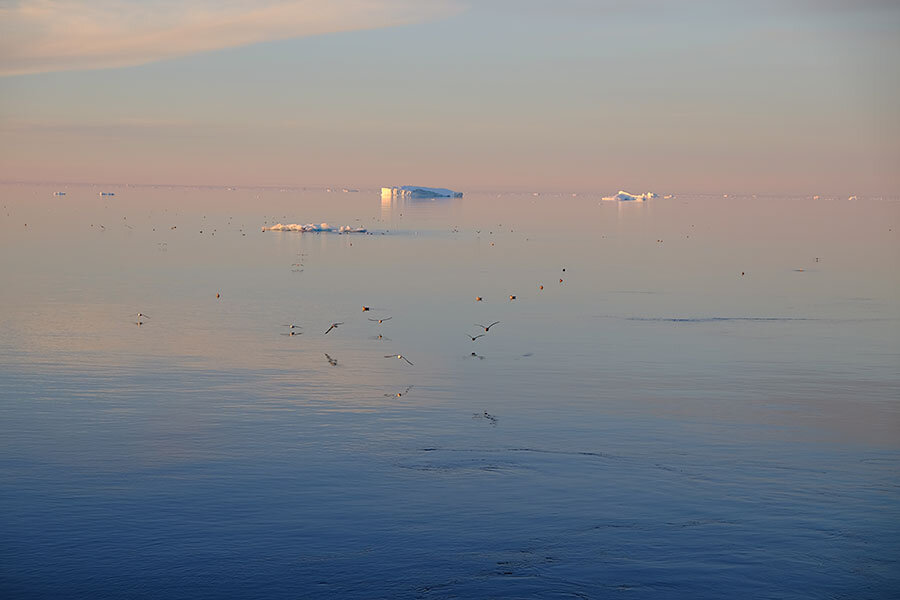Could bird droppings help curb warming in the Arctic?
Loading...
Humans curse bird poop when it ends up on their cars, patios, or – on the rare occasion – heads. But in the Arctic, the presence of avian excrement might actually be a good thing.
According to new research, seabird guano (a fancy scientific name for the poop that accumulates from animals like seabirds, bats, and seals) might be helping keep the polar region cold.
No, it's not directly acting as a thick, stinky blanket insulating the Arctic. Instead, as the birds' guano decomposes, it helps build another sort of cooling blanket: cloud cover.
And as a result, aerosols produced by bird poop could drive regional cooling by about a third as much as carbon dioxide produced by fossil fuels drives global warming, at least during the summer when the seabirds are present and producing guano in the Arctic, according to research published Tuesday in the journal Nature Communications.
"There is a connection between ecology and climate that certainly surprised me. The environment is very interconnected," study co-lead author Gregory Wentworth, an atmospheric scientist with Alberta Environment and Parks, says in a phone interview with The Christian Science Monitor. "How often do you hear about bird droppings being able to affect climate?"
Here's how it works: During the summertime, the Arctic is filled with migratory seabirds that use the region as their breeding grounds. As their guano decomposes, it releases ammonia.
Once in the atmosphere, that ammonia reacts with other gases, sulfuric acid and water vapor, to form new tiny particles. Cloud droplets form by condensing onto small atmospheric particles, so more particles means more cloud droplets.
And more cloud droplets in a cloud makes it brighter and more reflective. Clouds reflect solar radiation away from the Earth, helping to keep it cool. So having more, particularly reflective clouds across the Arctic helps cool it down.
"This ammonia is a key ingredient in this series of processes and chemical reactions that can change the reflectivity of clouds," Dr. Wentworth says. And with tens of millions of seabirds flocking to the Arctic to nest each summer, over 33,000 tons of ammonia is released from the guano each year.
Wentworth and colleagues found the first clue to the birds' impact while on a research vessel sailing through the Canadian Arctic in 2014. When Wentworth measured the atmospheric composition in the region, he was surprised to find ammonia in the air. Typically ammonia is rich around big agricultural and industrial centers, but the Arctic had neither.
Now, after modeling the contribution of decomposing seabird guano, Wentworth says he has found the ammonia-producing culprit.
This finding could also help resolve another puzzling observation in the Arctic, says Timothy Bates, an atmospheric chemist with the National Oceanic and Atmospheric Administration who was not involved in the research.
"There has been a lot of reports of new particle formation in the boundary layer in the summertime Arctic which is really unusual, at least from a global point of view," Dr. Bates says in an interview with the Monitor. "We don't see that over the open ocean and much of the rest of the globe. And so trying to explain it in the Arctic has not necessarily been easy … But it's certainly a lot easier to explain if you add in the ammonia emissions."
This isn't the first time scientists have found evidence that bird poop increases a region's ammonia and particle formation. Rodney Weber, an atmospheric chemist at the Georgia Institute of Technology, and his colleagues saw the same effect downwind of a penguin colony on an island between New Zealand and Antarctica.
Dr. Weber writes in an email to the Monitor that the assertion in this new study that the guano's influence extends across the whole Arctic rather than being a more localized phenomenon, although "a very novel idea," needs more concrete data to corroborate the model.
Should we start spreading bird poop across the Arctic to keep it cool?
"I would say not," writes Peter Convey, a scientist with the British Antarctic Survey who was not involved in this research, in an email to the Monitor. "The key human action that is required to do anything about 'warming', global or regional, is to reduce production of the source (CO2), rather than try to fall back on untested and very badly understood ideas of 'geoengineering'!"
There are all kinds of possible unknown effects of altering guano in the Arctic or the seabird populations that produce it, Dr. Convey says. Furthermore, he points out, the process of "making" guano also produces a significant amount of greenhouse gases, as is known for cow and other livestock, ahem, emissions.
As global warming continues, it is unclear how those changes will affect the seabird populations or their guano production, or the role the ammonia will play, Wentworth says. But now scientists have another process to fit into the complicate puzzle of the Arctic climate.








